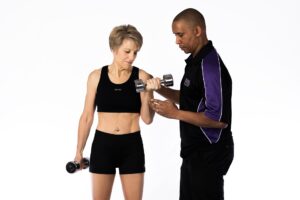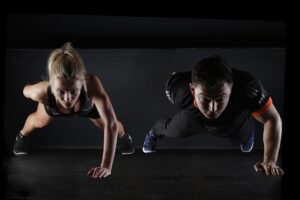How to teach your clients to breathe is really important to put their trust on you as a Coach.
If you’ve ever worked with a gym newbie, you probably realized two things:
First, they don’t know how to breathe correctly during exercise. Second, they don’t take the time to brace and prepare themselves for a bout of exercise.
You also probably noticed that teaching these two things can be a frustrating experience.
To that end, we’ve put together this brief guide to help you out. Let’s dive in.
But First: Why Do Breathing and Bracing Matter?
Breathing is crucial during exercise because it supplies your body with oxygen for aerobic energy production. More oxygen means your body can synthesize adenosine triphosphate (ATP) molecules, which fuel your muscles.
Adequate ATP synthesis is especially important during exercise because demands can increase 1,000-fold. In addition, even short and intense bouts of activity (e.g., sprints or a heavy set of deadlifts) heavily rely on oxygen. A lack of oxygen would limit your client’s performance and progress.
Bracing is the act of tensing an area of the body, typically the midsection or upper back. Doing so is crucial for creating a solid and stable position that promotes safety and reduces the risk of joint, muscle, and connective tissue injuries.
Proper bracing is also crucial for optimal power output and performance, especially during more intense activities, such as a heavy set of standing overhead presses.
How to Teach Bracing and Breathing to New Clients
1. Begin By Explaining the Importance
The first step is to get on the same page with your clients and explain the benefits of proper bracing and breathing during exercise.
Mastering the two would allow clients to:
- Train harder and perform better
- Maintain a strong and stable position
- Minimize the injury risk
- Master new exercises better
- Feel more stable and secure during workouts
2. Leverage Breathing Exercises
Using breathing techniques is an excellent way to help new clients. One popular technique that is crucial for heavy is the Valsalva maneuver. The objective is to take a deep belly breath, close your throat and exhale against it, creating intra-abdominal pressure.
Perform a rep, exhale, inhale again, and repeat. Doing so is crucial for creating midsection tension and stability.
3. Practice Bracing Patterns
Mastering the Valsalva maneuver will go a long way in promoting stability and helping you and your clients brace more effectively. In addition, here are a few cues that can help clients brace correctly:
- Shoulders back, also known as retraction and scapular depression, is when the trainee pushes their chest out, bringing their shoulder blades back and down to create a solid base
- Tense the midsection by squeezing the abs; a helpful cue is to try and bring your ribcage down and closer to the hip bone
- Squeeze glutes – the mental cue isn’t possible in every activity, but it can be fantastic during exercises where your hips are extended (e.g., standing overhead shoulder press)
Final Words
Breathing and bracing are two crucial skills every trainee needs to learn for safe and effective training.
Whether your clients want to run long distances, sprint, jump, or lift as much weight as possible, teaching these two skills will go a long way in keeping them safe.
The good news is that, as long as you teach clients to breathe correctly, they will find it much easier to brace before exercise.







